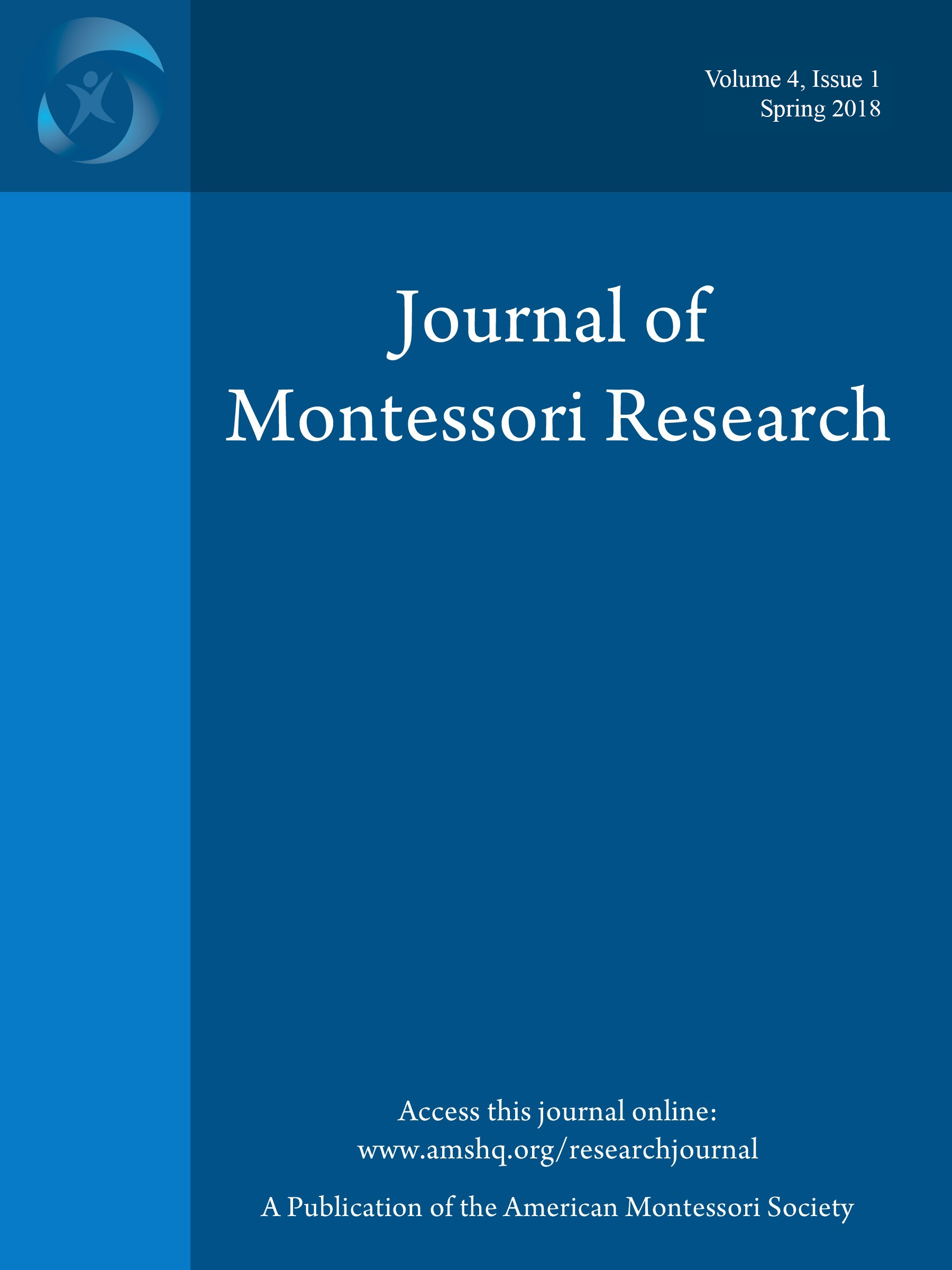Parents’ Reasons for Sending Their Child to Montessori Schools
DOI:
https://doi.org/10.17161/jomr.v4i1.6714Palavras-chave:
Montessori, school choice, educational principles, school fit, student outcomes, classroom environmentResumo
Although the Montessori Method of education is more than 100 years old, the number of Montessori schools in the United States has exponentially increased since 1990. Montessori methods and practices can be complex and difficult for parents to understand, even among parents whose child attends Montessori schools. Moreover, it is unclear why parents decide to enroll their child in Montessori schools. This study presents the results of a survey administered to 124 parents whose children were enrolled in 3 Montessori schools in Massachusetts. Findings indicate that 4 reasons motivated parents’ choice of Montessori education: attraction to Montessori principles, perceived fit with the Montessori philosophy or school, anticipated outcomes, and attraction to the Montessori classroom. These findings indicate that, to support parents’ decision-making, Montessori administrators should invest in parental and public awareness about Montessori education and provide prospective families with specific information related to school fit, classroom environment, and long-term student outcomes.
Referências
American Montessori Society. (n.d.). Frequently asked questions about Montessori. Retrieved from http://amshq.org/Montessori-Education/FAQs
Anderson, K. M., & Resnick, M. A. (1997). Careful comparisons: Public and private schools in America (ED 411 611). National School Boards Association. Retrieved from https://files.eric.ed.gov/fulltext/ED411611.pdf
Chattin-McNichols, J. (1992). The Montessori controversy. Albany, NY: Delmar.
Chertoff, E. (2012, December). The great Montessori schism. The Atlantic. Retrieved from http://www.theatlantic.com/national/archive/2012/12/the-great-montessori-schism/266217/
Dohrmann, K. (2003). Outcomes for students in a Montessori program: A longitudinal study of the experience in the Milwaukee Public Schools. Association Montessori International / USA. Retrieved from https://www.ami-global.org/sites/default/files/Outcomes_1.pdf
Enright, M. (2010). Foundations study guide: Montessori education. The Atlas Society. Retrieved from http://www.atlassociety.org/guide-montessori
Hainstock, E. G. (1997). The essential Montessori: An introduction to the woman, writings, the method, and the movement. New York, NY: Penguin.
Hiles, E. (2015). Measuring parent perception and understanding of Montessori education in three Massachusetts Montessori schools (Doctoral dissertation). Retrieved from ProQuest Dissertations and Theses Global. (UMI No. 3731884)
International Montessori Council. (n.d.) Welcome to the International Montessori Council. Retrieved from https://www.montessori.org/the-international-montessori-council-imc/
Koster-Hale, J., & Saxe, R. (2013). Functional neuroimaging of theory of mind. In S. Baron-Cohen, M. Lombardo, & H. Tager-Flusberg (Eds.) Understanding other minds: Perspectives from developmental social neuroscience (3rd ed.), pp. 132–163. New York, NY: Oxford University Press.
Laski, E. V., Vasilyeva, M., & Schiffman, J. (2016). Longitudinal comparison of place-value and arithmetic knowledge in Montessori and non-Montessori students. Journal of Montessori Research, 2(1), 1–15. https://doi.org/10.17161/jomr.v2i1.5677
Lillard, A. S. (2012). Preschool children’s development in classic Montessori, supplemented Montessori, and conventional programs. Journal of School Psychology, 50, 379–401. doi:10.1016/j.jsp.2012.01.001
Lillard, A. S., & Else-Quest, N. (2006). Evaluating Montessori education. Science, 313, 1893–1894. doi:10.1126/science.1132362
Lillard, A. S., & Heise, M. J. (2016). Removing supplementary materials from Montessori classrooms changed child outcomes. Journal of Montessori Research, 2(1), 16–26. https://doi.org/10.17161/jomr.v2i1.5678
Lillard, A. S., Heise, M. J., Richey, E. M., Tong, X., Hart, A., & Bray, P. M. (2017). Montessori preschool elevates and equalizes child outcomes: A longitudinal study. Frontiers in Psychology, 8, 1–19. https://doi.org/10.3389/FPSYG.2017.01783
Lillard, P. P. (1997). Montessori in the classroom. New York, NY: Schocken.
Lopata, C., Wallace, N. V., & Finn, K. V. (2005). Comparison of academic achievement between Montessori and traditional education programs. Journal of Research in Childhood Education, 20(1), 5–13. https://doi.org/10.1080/02568540509594546
Marshall, C. (2017). Montessori education: A review of the evidence base. npj Science of Learning, 2, 1–9. doi:10.1038/s41539-017-0012-7
Miles, M. B., Huberman, A. M., & Saldaña, J. (2013). Qualitative data analysis. Thousand Oaks, CA: SAGE.
Montessori, M. (1995). The absorbent mind. New York, NY: Henry Holt.
Morrison, G. S. (2014). Early childhood education today (13th ed.). New York, NY: Pearson.
Murray, A. K. (2008). Public perceptions of Montessori education (Doctoral dissertation). Available from ProQuest Dissertations & Theses Global. (UMI No. 3297628).
Murray, A. K. (2010). Overview of research on Montessori education: An evidence-based curriculum. American Montessori Society. Retrieved from https://amshq.org/~/media/46C230AC87F8472E9FE2B46E555A9D28.ashx
Murray, A. K. (2012). Public knowledge of Montessori education. Montessori Life, 24(1), 18–21.
National Center for Montessori in the Public Sector. (2014). Growth of public Montessori in the United States: 1975–2014. Retrieved from https://www.public-montessori.org/white-papers/growth-of-public-montessori-in-the-united-states-1975-2014/
North American Montessori Teachers’ Association. (n.d.). Frequently asked questions about Montessori education. Retrieved from http://www.montessori-namta.org/FAQ/Montessori-Education
Perry, S. (2016, January 25). “Prince George effect” on Montessori schools: Interest among parents up a whopping 65 percent. People. Retrieved from http://www.people.com/people/package/article/0,,20395222_20982199,00.html
Povell, P. (2010). Montessori comes to America: The leadership of Maria Montessori and Nancy McCormick Rambusch. Lanham, MD: University Press of America.
Rathunde, K. (2003). A comparison of Montessori and traditional middle schools: Motivation, quality of experience, and social context. The NAMTA Journal, 28(3), 12–52. Retrieved from https://www.ami-global.org/sites/default/files/RathundeComparison.pdf
Schmidt, M., & Schmidt, D. (2009). Understanding Montessori: A guide for parents. Indianapolis, IN: Dog Ear Publishing.
Seldin, T., & Davies, V. (2006). How to raise an amazing child the Montessori way. New York, NY: DK Publishing.
U.S. Department of Education, National Center for Education Statistics. (2016a). Table 205.10. Private elementary and secondary school enrollment and private enrollment as a percentage of total enrollment in public and private schools, by region and grade level: Selected years, fall 1995 through fall 2015. In U.S. Department of Education, National Center for Education Statistics (Ed.), Digest of Education Statistics (2016 ed.). Retrieved from https://nces.ed.gov/programs/digest/d16/tables/dt16_205.10.asp
U.S. Department of Education, National Center for Education Statistics. (2016b). Table 214.10. Number of public school districts and public and private elementary and secondary schools: Selected years, 1869–70 through 2014–15. In U.S. Department of Education, National Center for Education Statistics (Ed.), Digest of Education Statistics (2016 ed.). Retrieved from https://nces.ed.gov/programs/digest/d16/tables/dt16_214.10.asp
U.S. Department of Education, National Center for Education Statistics. (2016c). Table 214.40. Public elementary and secondary school enrollment, number of schools, and other selected characteristics, by locale: Fall 2011 through fall 2014. In U.S. Department of Education, National Center for Education Statistics (Ed.), Digest of Education Statistics (2016 ed.). Retrieved from https://nces.ed.gov/programs/digest/d16/tables/dt16_214.40.asp
Whitescarver, K., & Cossentino, J. (2008). Montessori and the mainstream: A century of reform on the margins. Teachers College Record, 110, 2571–2600.


